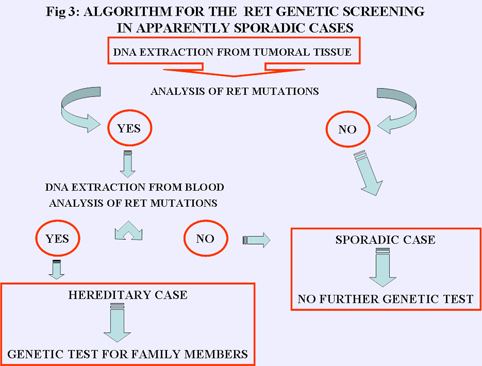Entrez 5979 | Ensembl ENSG00000165731 | |
 | ||
Aliases RET, Ret, PTC, RET51, RET9, c-Ret, CDHF12, CDHR16, HSCR1, MEN2A, MEN2B, MTC1, RET-ELE1, ret proto-oncogene External IDs MGI: 97902 HomoloGene: 7517 GeneCards: RET | ||
The RET proto-oncogene encodes a receptor tyrosine kinase for members of the glial cell line-derived neurotrophic factor (GDNF) family of extracellular signalling molecules. RET loss of function mutations are associated with the development of Hirschsprung's disease, while gain of function mutations are associated with the development of various types of human cancer, including medullary thyroid carcinoma, multiple endocrine neoplasias type 2A and 2B, pheochromocytoma and parathyroid hyperplasia.
Contents
Structure
RET is an abbreviation for "rearranged during transfection", as the DNA sequence of this gene was originally found to be rearranged within a 3T3 fibroblast cell line following its transfection with DNA taken from human lymphoma cells. The human gene RET is localized to chromosome 10 (10q11.2) and contains 21 exons.
The natural alternative splicing of the RET gene results in the production of 3 different isoforms of the protein RET. RET51, RET43 and RET9 contain 51, 43 and 9 amino acids in their C-terminal tail respectively. The biological roles of isoforms RET51 and RET9 are the most well studied in-vivo as these are the most common isoforms in which RET occurs.
Common to each isoform is a domain structure. Each protein is divided into three domains: an N-terminal extracellular domain with four cadherin-like repeats and a cysteine-rich region, a hydrophobic transmembrane domain and a cytoplasmic tyrosine kinase domain, which is split by an insertion of 27 amino acids. Within the cytoplasmic tyrosine kinase domain, there are 16 tyrosines (Tyrs) in RET9 and 18 in RET51. Tyr1090 and Tyr1096 are present only in the RET51 isoform.
The extracellular domain of RET contains nine N-glycosylation sites. The fully glycosylated RET protein is reported to have a molecular weight of 170 kDa although it is not clear to which isoform this molecular weight relates.
Kinase activation
RET is the receptor for GDNF-family ligands (GFLs).
In order to activate RET, GFLs first need to form a complex with a glycosylphosphatidylinositol (GPI)-anchored co-receptor. The co-receptors themselves are classified as members of the GDNF receptor-α (GFRα) protein family. Different members of the GFRα family (GFRα1, GFRα2, GFRα3, GFRα4) exhibit a specific binding activity for a specific GFLs. Upon GFL-GFRα complex formation, the complex then brings together two molecules of RET, triggering trans-autophosphorylation of specific tyrosine residues within the tyrosine kinase domain of each RET molecule. Tyr900 and Tyr905 within the activation loop (A-loop) of the kinase domain have been shown to be autophosphorylation sites by mass spectrometry. Phosphorylation of Tyr905 stabilizes the active conformation of the kinase, which, in turn, results in the autophosphorylation of other tyrosine residues mainly located in the C-terminal tail region of the molecule.
The structure shown to the left was taken from the protein data bank code 2IVT. The structure is that of a dimer formed between two protein molecules each spanning from amino acids 703-1012 of the RET molecule, covering RETs intracellular tyrosine kinase domain. One protein molecule, molecule A is shown in yellow and the other, molecule B in grey. The activation loop is coloured purple and selected tyrosine residues in green. Part of the activation loop from molecule B is absent.
Phosphorylation of Tyr981 and the additional tyrosines Tyr1015, Tyr1062 and Tyr1096 not covered by the above structure, have been shown to be important to the initiation of intracellular signal transduction processes.
Role of RET signalling during development
Mice deficient in GDNF, GFRα1 or the RET protein itself exhibit severe defects in kidney and enteric nervous system development. This implicates RET signal transduction as key to the development of normal kidneys and the enteric nervous system.
Clinical relevance
Activating point mutations in RET can give rise to the hereditary cancer syndrome known as multiple endocrine neoplasia type 2 (MEN 2). There are three subtypes based on clinical presentation: MEN 2A, MEN 2B, and familial medullary thyroid carcinoma (FMTC). There is a high degree of correlation between the position of the point mutation and the phenotype of the disease.
Chromosomal rearrangements that generate a fusion gene resulting in the juxtaposition of the C-terminal region of the RET protein with an N-terminal portion of another protein, can also lead to constitutive activation of the RET kinase. These types of mutations are associated with papillary thyroid carcinoma (PTC), and the fusion oncoproteins generated are termed RET/PTC proteins.
Disease database
The RET gene variant database at the University of Utah, identifies (as of November 2014) 166 mutations that are implicated in MEN2.
Interactions
RET proto-oncogene has been shown to interact with:
